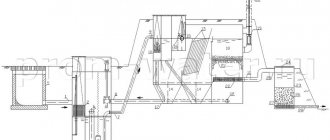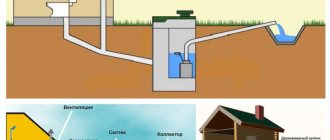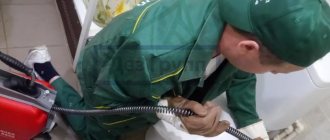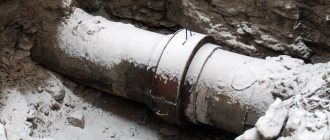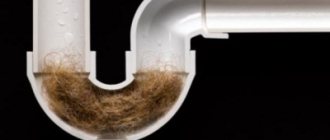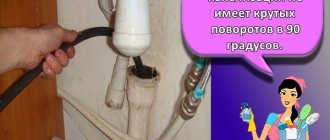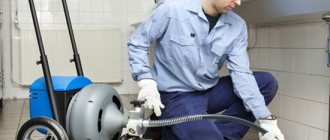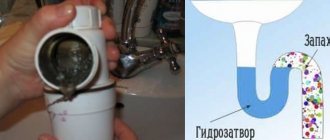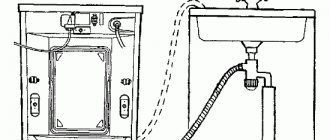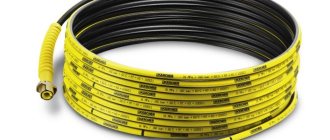Cleaning sewer pipes from grease
During the operation of the drainage system and the general system, grease begins to accumulate on the pipes, and because of this, it will be necessary to clean the sewer pipes from grease. It is important that you take care of the condition of the pipes in a timely manner and clean them if necessary. If using the sink has become completely impossible, then home owners will begin to wonder how to clean sewer pipes from grease deposits.
If the blockages are small, then you can easily deal with it on your own, but if all else fails, you will need to seek the help of a professional service.
How to remove grease deposits in pipes
A clog in a sewer pipe is definitely not the most pleasant phenomenon, which creates discomfort when using an apartment or house. For this reason, it is understandable to want to get rid of it as quickly as possible. But ideally, everything will be so that you don’t need to worry about it at all, and the owner will take preliminary measures to eliminate fat deposits.
Cleaning drains from grease deposits can be done in several different ways:
Using improvised means and folk methods.- Chemical substances.
- Mechanical cleaning.
- Hydrodynamic cleaning.
Each method has its own indications, as well as advantages and disadvantages.
Traditional methods
Available means include substances that are most likely to be found in every home. As a rule, this is vinegar, soda, and citric acid. If water has difficulty passing through the pipes, then before you buy a lot of expensive products, you should try to get rid of the grease in the sewer pipe using standard methods.
Soda
Baking soda itself can be an effective tool in the fight against fat deposits. It will be enough to pour a whole glass of the product into the sink drain, and then fill it with hot water and cover with a stopper so that the mixture stands for several hours. This method, unlike all the following, can be used even if you have metal pipes.
Vinegar and soda
It will be a little more effective to pour not just soda and water, but pour vinegar over the composition or add citric acid. As a result of the resulting chemical reaction, the soda will be extinguished, it will foam with bubbles, and this will have an effect on fat deposits, and excessive pressure from carbon dioxide, which will be formed due to the interaction of substances, will push the blockage. This method is indicated only for plastic pipes, but not for metal ones, as this sometimes causes damage, and as a result, becomes the root cause of corrosion.
Soda
Another great way to combat fat deposits at home is any soda like Coca-Cola, Sprite and other similar drinks. They contain orthophosphoric acid, which is harmless in small quantities, but it perfectly helps to deal with pipe blockages. There is only one drawback - the dye that is added to carbonated drinks can turn the plumbing fixtures white, so it is better to use colorless drinks to clean sinks.
Chlorine
The second way to clean a sewer pipe from grease is to use products that contain a high content of a component such as chlorine. This includes household chemicals, as well as inexpensive and extremely effective whiteness. It needs to be poured in large quantities (sometimes even several liters) into the drain and washed with plenty of water. There is often advice on forums that you can also use hydrochloric acid for cleaning.
Chemicals
But still, improvised means help to cope with minor blockages, and if this does not help, then the use of heavy artillery will be required. There are certain chemicals available for cleaning grease from drain pipes, and they are the most common option for dealing with grease deposits. They are sold in the form of liquids, tablets, dry powders, and granules. The latter will definitely contain alkali, which will make them preferable for use when cleaning pipes. When exposed to heated water, a violent reaction begins, and because of this, the substance begins to actively affect fat deposits, hair and even food debris that are preserved in the pipe, and all this dissolves. Later, all that remains is to turn on the water at full pressure and rinse the remaining product down the drain.
It is also worth paying attention to products that have an antiseptic effect. Usually they are o. Such products contain bacteria that help fight the root cause of the formation of unpleasant odors from pipes. Let's look at those that are recognized as the best.
"Mole"
This grease solvent is very popular, its cost is relatively small, but it is extremely effective. It is produced in dry and liquid form, and the first also has the antibacterial effect described above. There are many products called “Mole” on the household chemicals market, but they are produced by different companies, so the dissolution result is sometimes slightly different, but most people still trust it and prefer this particular pipe cleaner. The procedure for use is simple - pour it or pour it into the pipe, leave for 2-3 hours, and then rinse with plenty of heated water.
"Mister Muscle"
The product is produced in the form of granules and gel. The latter is thick in consistency, able to penetrate the pipe, even if you have stagnant water in the sink, and will help get rid of blockages in 20 minutes. To do this, pour half the container into the pipe, wait as long as indicated on the package, and then rinse everything with high pressure of hot water. Please remember that the product is caustic and can cause skin burns if you do not protect them in advance.
"Wa gi Pothan"
This product is considered one of the most powerful and effective, as it can remove grease and limescale deposits, papers, and food waste. As it is written in the instructions, with its help you can clean sewer pipes in a house or apartment in just a few minutes. But in this matter you should be extremely careful. Before using the product, open all windows, remove water from the sink and pour in the substances. Also, you should keep the packaging away from you at arm's length, turn away while falling asleep, and then pour more hot water into the sink hole as soon as possible, do not inhale the steam and leave everything for a few minutes. Then turn on the hot water from the tap. The product has an incredible effect, which is why it has earned a lot of positive reviews, but if it suddenly doesn’t work the first time, the procedure will need to be repeated.
"Tiret Turbo"
This brand of product is quite well known through advertising and positions itself as a professional cleaning of sewer pipes from grease. Tiret is produced in the form of a thick gel, which is able to penetrate the blockage even with standing water. It can be used to clean both plastic and metal pipes. Thanks to its unique composition, you will not only be able to remove grease blockages, but also disinfect pipes and remove unpleasant odors. When the product is poured into the hole, you will need to wait 5 minutes, and then rinse the pipes thoroughly with water. Despite its popularity, reviews about the product are vague, 50/50.
" D e b o u c h e r "
This is a tool that will help rid sewer pipes and siphons of grease blockages, food debris, hair, paper and threads. The 1 liter bottle is designed for a couple of uses. So, you should pour half the bottle into the drain hole, let it stand for 1.5-2 hours, and then rinse everything with hot water. If the blockage is large or the pipe is too long, it is recommended to pour out the entire bottle and leave the product to stand overnight, and then rinse everything with plenty of water. The product does not harm enamel and plastic, but under no circumstances should it be used on aluminum pipes.
When choosing a means for cleaning a sewer pipe from grease, you should read the instructions - different chemicals are intended for different pipes. Some will harm metal pipes and clean plastic, while others will make cast iron products cleaner, and plastic will simply become unusable. It is also equally important to remember that everything is done carefully, and only use chemicals while wearing gloves, and if the product has a strong odor, then a mask will not hurt. Caustic substances should be hidden as far as possible from children.
Diluting soda to flush the sewer pipe system
As mentioned earlier, there are three types in which this product is produced - liquid in the form of a gel or solution, solid in the form of a powder. “Mole” is purchased at a hardware store in a ready-made form, and pouring the solid substance into pipes is strictly prohibited; it must first be diluted. To do this, you will need 3-4 kg of soda, a device in the form of a spatula or scoop, and a metal or plastic container that will not be destroyed by the powder, since it is quite caustic.
To avoid damaging the skin of your hands, it is recommended to wear gloves, and to prevent the solution from getting on the mucous membranes, wear glasses. Pour the entire amount of soda bicarbonate with water in the amount of 7-7.5 liters of water and stir until it is completely dissolved. When combined with a liquid, the alkali begins to release a large amount of heat into the environment, so you need to know that the bucket with all its contents will heat up and may even become hot.
Mechanical cleaning methods
For especially dense blockages that are difficult to remove even with the help of chemicals, mechanical cleaning agents are suitable. We are talking about a plunger. The principle of operation is quite simple. It should be applied to the hole so that the rubber fits tightly to the sink, and apply pressure in the pipe with progressive movements, since it is under the influence of pressure that the plug will be removed. When the pressure reaches its peak, it will help clear the pipe from even the most stubborn blockages and grease. In addition, it will not take up much space, and the size of the plunger allows you to hide it away from prying eyes.
But the most effective method is a plumbing cable. It is made with a length of 10 to 50 meters, and a stiff brush is attached to one end and a handle to the other. The cable should be lowered into the pipe so that it rests against the blockage, and then you can begin cleaning by turning the handle. Most likely, you will need to put in some effort. Remaining deposits should be washed off with plenty of water.
To increase the efficiency of a hand spinner, you can use a drill, which will save time and effort. To combat complex blockages, you can also use steel belts. This tool is equipped with a comfortable handle and various attachments for effective work. Mechanical methods help eliminate fat deposits, but do not disinfect pipes. This will require additional use of special tools.
Professional cleaning
If you are unable to clean your sewer pipes of grease with your own hands, you will need the help of professionals. In their work, special services use hydrodynamic devices, which are often used to combat blockages in the septic tank.
Such a device is a pipe made of thick rubber, and a special tip is attached to its end. Water is supplied through the tube under high pressure, with the lower value being 190 MPa, and it is distributed through the tip. Water helps to have a strong impact on sediments, and the long length of the cable makes it possible to use the equipment to clean long and hard-to-reach pipes with large diameters, even yard sewers.
In addition, a sectional or drum-type blockage removal machine can also be classified as a professional-type device. This is an extremely effective tool for cleaning all types of pipes. A simpler option would be a car with a gasoline engine that can be moved throughout the building and beyond.
"Rifey" anti-grease: foam
The line of professional detergents of this brand includes a product in the form of foam, which also effectively removes grease stains
It can also be used if you need to clean pipes and drains from oil and fat deposits, and it does not matter whether they are of plant or animal origin.
Such professional cleaning chemicals are widely used in various areas - from catering units in schools and kindergartens to restaurants and cafes. Among its features are:
- rapid absorption into dirt,
- ease of dissolution in water,
- economical consumption,
- good wetting and degreasing properties,
- easy to wash off from any surface.
Chemicals for cafes, restaurants or catering establishments do not contain phosphates, silicates, and also maintain chemical stability under any conditions. The main condition is not to use the prepared solution on aluminum surfaces in order to avoid negative effects on them.
Preventive measures
As a rule, it is better to try not to go to extremes, but to take care of the condition of the sewer pipes inside the house in your apartment or house regularly. To do this, it will be enough to use a bag of cleansing mixture once every 2-3 months. It can be left even overnight to improve the effect of chemical cleansing. The frequency of the procedure will depend on how often you use the sink.
Also, the improvised means mentioned above - vinegar, soda - will also be an excellent preventive measure. Yes, this will not help cope with severe blockages, but it will help as a preventive measure to prevent the formation of blockages. And future sewer cleaning from fat deposits will be much easier. Since fat can turn into a film and remain on the walls of pipes at a relatively low temperature, it is better to rinse pipes and wash dishes with hot water. It is advisable to avoid getting leftover food (especially solid food) into the sewer system, as in this case the pipes will clog faster.
Scope of application of sodium hydroxide
Basically, this is the elimination of severe contamination, since the product effectively dissolves dirt, fat accumulation, soot, carbon deposits, and oil stains. Alkaline properties are used to neutralize acidic wastewater. Thanks to these properties, the product is effectively used for cleaning sewage drains; it perfectly dissolves organic components contained in contaminants; soda copes with all this without difficulty.
You can do this cleaning yourself without much difficulty; you don’t need any special skills for this. You just need to pour the product into the pipes and wait a certain time, then rinse with running water for several minutes, repeat the procedure if necessary.
How clogs appear
Blockages can appear during prolonged use of the sink. When you wash dishes, food and detergent residues are washed into the pipes, and a film of grease forms on the walls. Debris, particles of dirt and food will stick to it, which can clog the pipeline. The layer will begin to build up, the gap will become smaller, and water will become more difficult to pass through.
Such a nuisance can happen not only in the kitchen, because people often flush leftover food down the toilet, and clogs can even appear in the bathroom due to soap scum. This problem is encountered everywhere - in canteens, restaurants and public institutions. The fat film is an excellent breeding ground for bacteria. Therefore, the pipes will often become covered with an unpleasant black slime from the inside, and this will cause a nauseating odor. In addition to unpleasant sensations, such consequences of clogged pipes can even become dangerous to human health.
Signs that there is a blockage in the pipe:
- The water did not go away as quickly as before.
- After flushing the siphon, nothing changed.
- Unpleasant smell from the pipe.
Sometimes there are cases when stagnant water begins to overflow into another device. For example, if you turn on the faucet in the kitchen, the sewer in the bathroom will begin to rise. This means that the blockage is in the outlet from the main riser or in the riser itself, if we are talking about an apartment and not a house. In private homes, in this state of affairs, it is worth looking for the cause in the pipeline that goes to the septic tank or cesspool.
Why is the formation of fatty deposits dangerous?
Fatty deposits are also dangerous because, settling on the walls of the pit, they form a sticky film. The film has the ability to retain fragments of small particles. Gradually filling all the free space of the soil with insoluble particles that settle on a layer of fat, the wall in the cesspool becomes covered with an insoluble crust. Sometimes small stones form and settle to the bottom, gradually filling the hole.
The combination of factors such as insoluble wall crust, stones, and the formation of plaque in places leads to a deterioration in cleaning properties. Water stops filtering through the soil, as all the pores become clogged. The pit turns into a simple storage tank filled with a viscous liquid. A persistent pungent odor begins to appear. In winter, this is accompanied by freezing of the sump tank. The emerging problem poses the task of solving it in accessible and economical ways. First of all, removing fat deposits.
